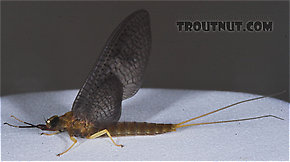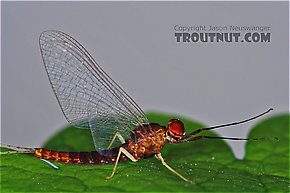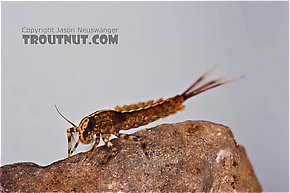Blog & Latest Updates
Fly Fishing Articles
Insects by Common Name


Mayfly Genus Isonychia (Slate Drakes)
Taxonomic Navigation -?-
Kingdom
Animalia (Animals)
» Phylum
Arthropoda (Arthropods)
» Class
Insecta (Insects)
» Order
Ephemeroptera (Mayflies)
» Family
Isonychiidae (Slate Drakes)
» Genus Isonychia (Slate Drakes)
| Species in Isonychia | ||
| Isonychia bicolorMahogany Dun | 0 | 0 |
| Isonychia campestrisSlate Drake | 0 | 0 |
| Isonychia siccaSlate Drake | 0 | 0 |
| Isonychia velmaSlate Drake | 0 | 0 |
12 species aren't included.
Common Names
The spinners, and occasionally the duns, produce more concentrated action, but the real value of the Isonychia hatch is its duration and the size of the flies; large trout become ever watchful for them, even when they aren't emerging.
All the species of Isonychia are similar in appearance and behavior.
Where & When
Regions: East, Midwest, West
Preferred Waters: Best in freestone streams
Isonychia is mostly important in the East and Midwest, where all the action is provided by Isonychia bicolor. The former species Isonychia sadleri and Isonychia harperi were recently discovered to be synonyms (Synonym: A former name of a taxon, usually a species. Entomologists frequently discover that two insects originally described as different species are one in the same, and they drop one of the names. The dropped name is said to be a synonym of the remaining name. These changes take a while to trickle into the common knowledge of anglers; for example, Baetis vagans is now a synonym of Baetis tricaudatus.) of bicolor. In the West, Isonychia hatches are not very important, and they may be attributed to several minor species, especially Isonychia velma.Preferred Waters: Best in freestone streams
Some people say the Isonychia species are multibrooded (Multibrooded: Producing more than one generation in a single year. Baetis mayflies are a classic example. Insects which produce a single generation with two distinct peaks (like the June and September hatches of Isonychia bicolor mayflies) are not multibrooded, because the fall insects are offspring from the previous fall instead of the current year's spring.), but this is not technically correct, even though their pattern of emergence is similar. In true multibrooded (Multibrooded: Producing more than one generation in a single year. Baetis mayflies are a classic example. Insects which produce a single generation with two distinct peaks (like the June and September hatches of Isonychia bicolor mayflies) are not multibrooded, because the fall insects are offspring from the previous fall instead of the current year's spring.) mayflies like the Baetidae, the flies emerging in midsummer or Fall are the offspring of the earlier hatch from the same year. In Isonychia, the Fall emergers are offspring from the previous Fall. They are present as half-grown nymphs when the first of their generation emerge.
Hatching Behavior
Isonychia duns may emerge on the surface or by crawling out onto shore. This behavior can vary within a single species, and it seems to depend on geographic location and the weather conditions.
Spinner Behavior
Time Of Day: Dusk
Habitat: Riffles
Isonychia duns molt into spinners within a couple days of hatching, and when they return they provide much more concentrated action than the emergence. They mate in swarms twenty to thirty feet in the air, and the females drop their eggs from high above the water before they join the males in falling spent (Spent: The wing position of many aquatic insects when they fall on the water after mating. The wings of both sides lay flat on the water. The word may be used to describe insects with their wings in that position, as well as the position itself.). Some conflicting accounts say the females oviposit by descending to dip the tips of their abdomens into the water over and over.Habitat: Riffles
I experienced a good Isonychia bicolor year on one northern Wisconsin river during which there were many duns for up to a month, but I never saw any spinners despite fishing appropriate riffles dozens of times at dusk. I have not solved this mystery, but there is more to timing these events than has been so far discovered.
Nymph Biology
Diet: Mostly plankton; sometimes other aquatic insects
Current Speed: Medium to Fast
Substrate: Boulders and gravel
Environmental Tolerance: Quite tolerant of pollution and marginal temperature
Isonychia nymphs are among of the fastest-swimming mayflies in the world. They can power their way through fast riffles with ease, and their imitations should be fished with fast twitches. Current Speed: Medium to Fast
Substrate: Boulders and gravel
Environmental Tolerance: Quite tolerant of pollution and marginal temperature
They are very unusual mayfly nymphs for three reasons:
- They have tufts of setae (Seta: Little hairs on insects.) on the insides of their forelegs which they hold up in the current as nets to filter out plankon for food.
- Despite their superb plankton-feeding capabilities, they are also among the few types of predatory mayflies. They may feed on midge and caddis larvae and smaller mayfly nymphs.
- They are unique among mayflies in that they have extra tuft-shaped gills at the base of their fore legs, a structure normally found in stoneflies.
Pictures of 20 Mayfly Specimens in the Genus Isonychia:
Female Isonychia bicolor (Mahogany Dun) Mayfly Dun View 13 Pictures
View 13 Pictures
 View 13 Pictures
View 13 PicturesCollected June 14, 2005 from the Namekagon River in Wisconsin
Added to Troutnut.com by Troutnut on May 26, 2006
Added to Troutnut.com by Troutnut on May 26, 2006
Male Isonychia bicolor (Mahogany Dun) Mayfly Spinner View 15 PicturesI got several really nice pictures of this spinner. I also collected a female on the same trip.
View 15 PicturesI got several really nice pictures of this spinner. I also collected a female on the same trip.
 View 15 PicturesI got several really nice pictures of this spinner. I also collected a female on the same trip.
View 15 PicturesI got several really nice pictures of this spinner. I also collected a female on the same trip.Collected August 9, 2006 from the West Branch of Owego Creek in New York
Added to Troutnut.com by Troutnut on August 11, 2006
Added to Troutnut.com by Troutnut on August 11, 2006
Isonychia bicolor (Mahogany Dun) Mayfly Nymph View 7 PicturesThis Isonychia bicolor nymph from the Catskills displays the prominent white stripe sometimes characteristic of its species. This is the first such specimen I've photographed, because members of the same species in the Upper Midwest have a more subdued stripe (and were once thought to be a different species, Isonychia sadleri). The striking coloration on this eastern nymph is more appealing.
View 7 PicturesThis Isonychia bicolor nymph from the Catskills displays the prominent white stripe sometimes characteristic of its species. This is the first such specimen I've photographed, because members of the same species in the Upper Midwest have a more subdued stripe (and were once thought to be a different species, Isonychia sadleri). The striking coloration on this eastern nymph is more appealing.
 View 7 PicturesThis Isonychia bicolor nymph from the Catskills displays the prominent white stripe sometimes characteristic of its species. This is the first such specimen I've photographed, because members of the same species in the Upper Midwest have a more subdued stripe (and were once thought to be a different species, Isonychia sadleri). The striking coloration on this eastern nymph is more appealing.
View 7 PicturesThis Isonychia bicolor nymph from the Catskills displays the prominent white stripe sometimes characteristic of its species. This is the first such specimen I've photographed, because members of the same species in the Upper Midwest have a more subdued stripe (and were once thought to be a different species, Isonychia sadleri). The striking coloration on this eastern nymph is more appealing.Collected April 19, 2006 from the Beaverkill River in New York
Added to Troutnut.com by Troutnut on April 21, 2006
Added to Troutnut.com by Troutnut on April 21, 2006
Recent Discussions of Isonychia
Are Isonychia mayflies technically multibrooded? 4 Replies »
Here's what I've written in my article on Isonychia about their hatching:
I'm curious if they can really be called multibrooded or not, since they don't produce more than one generation per year (as far as I know). They simply have distinct populations within the same generation which emerge at different times during the year. Does that count?
All my books are packed up in boxes right now so I don't have a technical definition of the term handy.
ReplyPenns Creek Slate Draker's 4 Replies »Some Isonychia species are multibrooded, but not in the same way as most other multibrooded mayflies like the Baetidae. In those species, the flies emerging in midsummer or Fall are the offspring of the earlier hatch from the same year. In Isonychia, the Fall emergers are offspring from the previous Fall. They are present as half-grown nymphs when the first of their generation emerge. Although Isonychia broods have distinct peaks, some may be found on the water at any time in between.
I'm curious if they can really be called multibrooded or not, since they don't produce more than one generation per year (as far as I know). They simply have distinct populations within the same generation which emerge at different times during the year. Does that count?
All my books are packed up in boxes right now so I don't have a technical definition of the term handy.
Penns is one of the few places where a #10 iso will nail em' all year long
ReplyIso 1 Reply »Posted by JMV on Sep 21, 2006 in the species Isonychia bicolor
Last reply on Sep 21, 2006 by Troutnut
Great site, I'm an Iso. fanatic... JM
ReplyThere are 2 more topics.
Your Thoughts On Isonychia:
Top 10 Fly Hatches
Top Gift Shop Designs
Eat mayflies.
Top Insect Specimens
Miscellaneous Sites
Troutnut.com is copyright © 2004-2024 Jason
Neuswanger (email Jason). See my FAQ for information about use of my images.
 privacy policy
privacy policy
